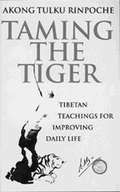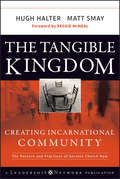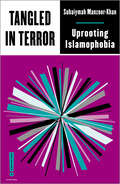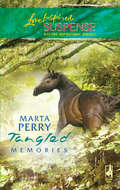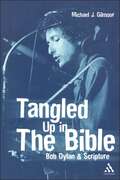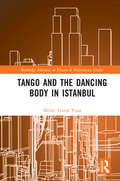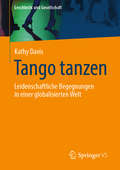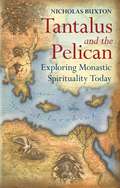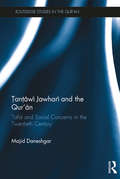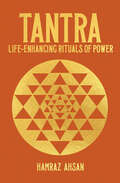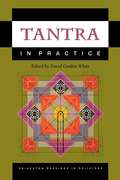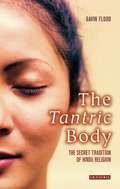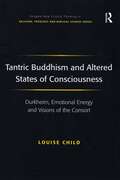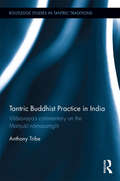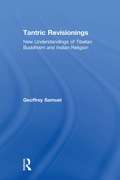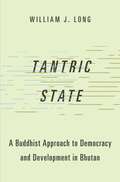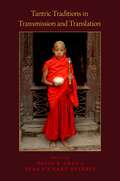- Table View
- List View
Taming The Tiger: Tibetan Teaching For Improving Daily Life
by Akong Tulku RinpocheTAMING THE TIGER offers a simple approach to finding happiness for oneself that also brings happiness to others. Based on twenty years of Buddhist teaching in the West, Taming the Tiger aims to help anyone seeking the truth about suffering and happiness. The first part of the book deals with topics such as Impermanence, The Right Motivation, Facing the Situation, Body, Speech and Mind, Compassion, and Mindfulness. The second part is devoted to exercises, meditations and relaxation techniques for body and mind, including Feeling, Openness, Taking Suffering, Bringing the Buddha to Life and Universal Compassion. The exercises, designed to provide a base of self-knowledge, mind-therapy and self-healing have also been found beneficial in therapy workshops and in the treatment of psychological problems.This practical programme has been tested and refined first at therapy workshops of Samye Ling in Scotland - the oldest Tibetan Buddhist centre in the West - and has since confirmed its success in cities throughout Europe, North America and Africa, bringing definitive solutions to long-term problems weighing heavily on the mind.
The Tangible Kingdom: Creating Incarnational Community (Jossey-Bass Leadership Network Series #37)
by Hugh Halter Matt SmayWritten for those who are trying to nurture authentic faith communities and for those who have struggled to retain their faith, The Tangible Kingdom offers theological answers and real-life stories that demonstrate how the best ancient church practices can re-emerge in today's culture, through any church of any size. In this remarkable book, Hugh Halter and Matt Smay "two missional leaders and church planters" outline an innovative model for creating thriving grass-roots faith communities.
The Tangible Kingdom: Creating Incarnational Community (Jossey-Bass Leadership Network Series #25)
by Hugh Halter Matt SmayWritten for those who are trying to nurture authentic faith communities and for those who have struggled to retain their faith, The Tangible Kingdom offers theological answers and real-life stories that demonstrate how the best ancient church practices can re-emerge in today's culture, through any church of any size. In this remarkable book, Hugh Halter and Matt Smay "two missional leaders and church planters" outline an innovative model for creating thriving grass-roots faith communities.
Tangled in Terror: Uprooting Islamophobia (Outspoken by Pluto)
by Suhaiymah Manzoor-Khan'Lyrical and uncompromising - Suhaiymah writes to disrupt' - gal-dem Islamophobia is everywhere. It is a narrative and history woven so deeply into our everyday lives that we don’t even notice it – in our education, how we travel, our healthcare, legal system and at work. Behind the scenes it affects the most vulnerable, at the border and in prisons. Despite this, the conversation about Islamophobia is relegated to microaggressions and slurs. Suhaiymah Manzoor-Khan reveals how Islamophobia not only lives under the skin of those who it marks, but is an international political project designed to divide people in the name of security, in order to materially benefit global stakeholders. It can only be truly uprooted when we focus not on what it is but what it does. Tangled in Terror shows that until the most marginalised Muslims are safe, nobody is safe.
Tangled in Terror: Uprooting Islamophobia (Outspoken by Pluto)
by Suhaiymah Manzoor-Khan'Lyrical and uncompromising - Suhaiymah writes to disrupt' - gal-dem Islamophobia is everywhere. It is a narrative and history woven so deeply into our everyday lives that we don’t even notice it – in our education, how we travel, our healthcare, legal system and at work. Behind the scenes it affects the most vulnerable, at the border and in prisons. Despite this, the conversation about Islamophobia is relegated to microaggressions and slurs. Suhaiymah Manzoor-Khan reveals how Islamophobia not only lives under the skin of those who it marks, but is an international political project designed to divide people in the name of security, in order to materially benefit global stakeholders. It can only be truly uprooted when we focus not on what it is but what it does. Tangled in Terror shows that until the most marginalised Muslims are safe, nobody is safe.
Tangled Memories (Mills And Boon Love Inspired Ser.)
by Marta PerryFinally meeting the wealthy family she'd never known should have given Corrie Grant the information about her father she'd craved all her life.
Tangled Up in the Bible: Bob Dylan and Scripture
by Michael J. GilmourBob Dylan has had a profound influence on the shape of modern pop music (folk, rock, blues) and as a modern literary figure. He has also attracted enormous attention from both professional and amateur "interpreters". In this book Gilmour offers a thorough study of Dylan's reading of scriptures. He explores the ways in which Dylan transforms biblical images and concepts when he incorporates them into his literary world; it is an attempt to listen to the echoes of scripture in his published works. Gilmour closely reads Dylan's poems and songs and provides commentaries on several themes found in Dylan's work: the Sermon on the Mount and Jesus; apocalypse, justice and judgement; oppressive religion and religious irony. Through these readings, Gilmour calls attention to the various ways Dylan uses scripture both in an explicit and an implicit manner.
Tango and the Dancing Body in Istanbul (Routledge Advances in Theatre & Performance Studies)
by Melin Levent YunaTango and the Dancing Body in Istanbul explores the expansion of social Argentine tango dancing among Muslim actors in Turkey, pioneered in Istanbul despite the conservative rule of the Justice and Development Party (JDP) and Tayyip Erdoğan. In this book, Melin Levent Yuna questions why a dance that appears to publicly represent an erotic relationship finds space to expand and increase dramatically in the number of contemporary Turkish Muslim tango dancers, particularly during a conservative rule. Even during the 2020 Covid-19 pandemic, tango dance classes, gatherings, and messages flourished on YouTube, Facebook, Instagram, and Zoom. Urban Turkey and its tango dance performances provide one symbol and example of how neoliberal capitalism could go hand in hand with conservatism by becoming a bridge between Europe and the Middle East. This study largely focuses on the dancers’ perspective while presenting the policies of Erdoğan. It presents the social characteristics of the tango dancers, the meanings they attach to their bodies and their dance as well as what this dance reflects about them – besides the policies of the Justice and Development Party. The book approaches the tango dance and its dancing body in terms of layers of meaning systems in a neoliberal and conservative context. This study will be of great interest to students and scholars in dance, anthropology, cultural studies, and performance studies.
Tango and the Dancing Body in Istanbul (Routledge Advances in Theatre & Performance Studies)
by Melin Levent YunaTango and the Dancing Body in Istanbul explores the expansion of social Argentine tango dancing among Muslim actors in Turkey, pioneered in Istanbul despite the conservative rule of the Justice and Development Party (JDP) and Tayyip Erdoğan. In this book, Melin Levent Yuna questions why a dance that appears to publicly represent an erotic relationship finds space to expand and increase dramatically in the number of contemporary Turkish Muslim tango dancers, particularly during a conservative rule. Even during the 2020 Covid-19 pandemic, tango dance classes, gatherings, and messages flourished on YouTube, Facebook, Instagram, and Zoom. Urban Turkey and its tango dance performances provide one symbol and example of how neoliberal capitalism could go hand in hand with conservatism by becoming a bridge between Europe and the Middle East. This study largely focuses on the dancers’ perspective while presenting the policies of Erdoğan. It presents the social characteristics of the tango dancers, the meanings they attach to their bodies and their dance as well as what this dance reflects about them – besides the policies of the Justice and Development Party. The book approaches the tango dance and its dancing body in terms of layers of meaning systems in a neoliberal and conservative context. This study will be of great interest to students and scholars in dance, anthropology, cultural studies, and performance studies.
Tango tanzen: Leidenschaftliche Begegnungen in einer globalisierten Welt (Geschlecht und Gesellschaft #64)
by Kathy DavisTangotanzen ist weltweit in Mode gekommen – eine Erfolgsstory mit vielen Gesichtern. Neben ökonomischen, historischen und politischen Aspekten spielen Sinnlichkeit und Emotionalität eine große Rolle, wie dieses Buch am Beispiel von Buenos Aires und Amsterdam zeigt. Grenzüberschreitend können empathische Gemeinschaften entstehen, die der sozialen Deprivation der Spätmoderne entgegen wirken und der Debatte um die Beziehung von globalem Süden und Norden neue Facetten hinzufügen.
Tantalus and the Pelican: Exploring Monastic Spirituality Today
by Nicholas BuxtonThis is an informative and engaging book about monasticism, its history, practice, and relevance to contemporary life, combining personal insights with sound scholarship. Buxton begins with a focus on the early days of Christian monasticism and the transmission of this tradition to Western Europe, concentrating on particular themes or figures of interest and seeking to draw parallels with the present-day. He then explores the central features of monastic life, such as silence and humility, drawing on personal experience as well as foundational literature. Part three examines the contemporary relevance of monasticism, suggesting that the core Benedictine principles of stability, conversion, and obedience offer a framework for an alternative way of being that may enable our everyday lives to be enriched and even transformed.
Tantawi Jawhari and the Qur'an: Tafsir and Social Concerns in the Twentieth Century (Routledge Studies in the Qur'an)
by Majid DaneshgarShaykh Ṭanṭāwī Jawharī was an Egyptian exegete known for having produced a scientific interpretation of the Qurʾān. A pioneering scholar in terms of familiarising the people of his time with many previously neglected matters regarding Islam and science, his publications shocked the Cairo educational system and other Muslim places of learning in the early twentieth century. This book examines the intersection between Ṭanṭāwī Jawharī and Egyptian history and culture, and demonstrates that his approach to science in the Qurʾān was intimately connected to his social concerns. Divided into three parts, part one contains three chapters which each introduce different aspects of Ṭanṭāwī Jawharī himself. The second part explores the main aspects of his tafsīr, discussing his approach to science and the Qurʾān, and how he presented Europeans in his tafsīr, and then addressing the impact of his tafsīr on wider Muslim and non-Muslim society. The third section draws attention to the themes from all 114 sūras of the Qurʾān that are discussed within his commentary. It then analyses the current status of his views and the post-Jawharism perspective on science and the Qurʾān, both today and in an imaginary future, in 2154. Providing new English translations of Ṭanṭāwī Jawharī’s work, the book delivers a comprehensive assessment of this unique figure, and emphasises the distinctive nature of his reading of the Qurʾān. The book will be a valuable resource for anyone studying modern Egypt, the Qurʾān, Islam and Science, and scientific interpretation and inimitability.
Tantawi Jawhari and the Qur'an: Tafsir and Social Concerns in the Twentieth Century (Routledge Studies in the Qur'an)
by Majid DaneshgarShaykh Ṭanṭāwī Jawharī was an Egyptian exegete known for having produced a scientific interpretation of the Qurʾān. A pioneering scholar in terms of familiarising the people of his time with many previously neglected matters regarding Islam and science, his publications shocked the Cairo educational system and other Muslim places of learning in the early twentieth century. This book examines the intersection between Ṭanṭāwī Jawharī and Egyptian history and culture, and demonstrates that his approach to science in the Qurʾān was intimately connected to his social concerns. Divided into three parts, part one contains three chapters which each introduce different aspects of Ṭanṭāwī Jawharī himself. The second part explores the main aspects of his tafsīr, discussing his approach to science and the Qurʾān, and how he presented Europeans in his tafsīr, and then addressing the impact of his tafsīr on wider Muslim and non-Muslim society. The third section draws attention to the themes from all 114 sūras of the Qurʾān that are discussed within his commentary. It then analyses the current status of his views and the post-Jawharism perspective on science and the Qurʾān, both today and in an imaginary future, in 2154. Providing new English translations of Ṭanṭāwī Jawharī’s work, the book delivers a comprehensive assessment of this unique figure, and emphasises the distinctive nature of his reading of the Qurʾān. The book will be a valuable resource for anyone studying modern Egypt, the Qurʾān, Islam and Science, and scientific interpretation and inimitability.
Tantra: Life-Enhancing Rituals of Power (Arcturus Hidden Knowledge)
by Hamraz AhsanTantric rituals are used to connect with divine energies and expand our consciousness. Its practices originate from Indian medieval scriptures and informs strands in Hindu, Jain and Buddhist thought. Yoga, meditation and art all formed a part of its rich, historic lineage.In this book we uncover and explain the ideas contained within this complex system of thought and introduce simple exercises to put these ideas into practice. Understanding how to weave together the energies within us leads to a completion of the self that feeds ever-greater health and happiness. Sections include:• Scripture and experience• Beginning with the breath• Nyasa and the art of touch• Daily modern rituals
Tantra in Practice (Princeton Readings In Religions Ser.)
by David WhiteAs David White explains in the Introduction to Tantra in Practice, Tantra is an Asian body of beliefs and practices that seeks to channel the divine energy that grounds the universe, in creative and liberating ways. The subsequent chapters reflect the wide geographical and temporal scope of Tantra by examining thirty-six texts from China, India, Japan, Nepal, and Tibet, ranging from the seventh century to the present day, and representing the full range of Tantric experience--Buddhist, Hindu, Jain, and even Islamic. Each text has been chosen and translated, often for the first time, by an international expert in the field who also provides detailed background material. Students of Asian religions and general readers alike will find the book rich and informative. The book includes plays, transcribed interviews, poetry, parodies, inscriptions, instructional texts, scriptures, philosophical conjectures, dreams, and astronomical speculations, each text illustrating one of the diverse traditions and practices of Tantra. Thus, the nineteenth-century Indian Buddhist Garland of Gems, a series of songs, warns against the illusion of appearance by referring to bees, yogurt, and the fire of Malaya Mountain; while fourteenth-century Chinese Buddhist manuscripts detail how to prosper through the Seven Stars of the Northern Dipper by burning incense, making offerings to scriptures, and chanting incantations. In a transcribed conversation, a modern Hindu priest in Bengal candidly explains how he serves the black Goddess Kali and feeds temple skulls lentils, wine, or rice; a seventeenth-century Nepalese Hindu praise-poem hammered into the golden doors to the temple of the Goddess Taleju lists a king's faults and begs her forgiveness and grace. An introduction accompanies each text, identifying its period and genre, discussing the history and influence of the work, and identifying points of particular interest or difficulty. The first book to bring together texts from the entire range of Tantric phenomena, Tantra in Practice continues the Princeton Readings in Religions series. The breadth of work included, geographic areas spanned, and expert scholarship highlighting each piece serve to expand our understanding of what it means to practice Tantra.
The Tantric Body: The Secret Tradition of Hindu Religion
by Gavin FloodTantra ('woven together' in Sanskrit) is the Hindu-based religion which links ecstatic sexual practice with meditation and direct spiritual experience. It originated 1200 years ago, when the great erotic temples (such as those at Orissa, Srisailam and Khajuraho) were built. In the West it is now best known for the inspiration of tantric yoga, and its associated ritualistic forms of sex. But is Tantra just about esoteric sexual practice or does it amount to something more? This lively and original book contibutes to a more complete understanding of Tantra's mysteries by discussing the idea of the body in Hindu tantric thought and practice in India.Without minimising its sexual dimensions, the author argues that within Tantra the body is more than just a sexual entity. It is a vehicle for the spirituality that is fundamental to people's lives. The tantric body cannot be understood outside the traditions and texts that give it form. Through practice (ritual, yoga and 'reading') the body is formed into a pattern determined by tradition, and the practitioner thereby moulds his or her life into the shape of the tradition. While there is a great range of tantric bodies - from ascetics living in cremation grounds, to low caste people possessed by tantric deities, to sophisticated high caste brahmans expounding the ascetic philosophy of Tantra - all share certain common assumptions and processes. Flood argues that while there is a divergence at different social levels and in different levels of tantric metaphysical claims, these levels are united by a process which the author calls 'entextualisation of the body'. The body becomes the text through the tradition being inscribed on it. This general claim is tested against specific ritual and doctrinal examples, and the tantric traditions are linked to wider social and political forces.'The Tantric Body' makes an important and fascinating contribution to the study of south Asian religion, and will have strong appeal to students of south Asian societies and cultures as well as to those of comparative philosophy.
Tantric Buddhism and Altered States of Consciousness: Durkheim, Emotional Energy and Visions of the Consort (Routledge New Critical Thinking in Religion, Theology and Biblical Studies)
by Louise ChildThis book explores the role of altered states of consciousness in the communication of social and emotional energies, both on a societal level and between individual persons. Drawing from an original reading of Durkheimian social theorists (including Mauss, Hertz, and Hubert) and Jungian psychology, Louise Child applies this analysis to tantric Buddhist ritual and biographical material. She suggests ways in which dreams and visionary experiences (including those related to the 'subtle body') play an important and previously under-explored role in tantric understandings of the consort relationship.
Tantric Buddhism and Altered States of Consciousness: Durkheim, Emotional Energy and Visions of the Consort (Routledge New Critical Thinking in Religion, Theology and Biblical Studies)
by Louise ChildThis book explores the role of altered states of consciousness in the communication of social and emotional energies, both on a societal level and between individual persons. Drawing from an original reading of Durkheimian social theorists (including Mauss, Hertz, and Hubert) and Jungian psychology, Louise Child applies this analysis to tantric Buddhist ritual and biographical material. She suggests ways in which dreams and visionary experiences (including those related to the 'subtle body') play an important and previously under-explored role in tantric understandings of the consort relationship.
Tantric Buddhist Practice in India: Vilāsavajra’s commentary on the Mañjuśrī-nāmasaṃgīti (Routledge Studies in Tantric Traditions)
by Anthony TribeUsing a commentary on the influential text, the Mañjuśrī-nāmasaṃgīti, ‘The Chanting of the Names of Mañjuśrī’, this book deals with Buddhist tantric meditation practice and its doctrinal context in early-medieval India. The commentary was written by the 8th-9th century Indian tantric scholar Vilāsavajra, and the book contains a translation of the first five chapters. The translation is extensively annotated, and accompanied by introductions as well as a critical edition of the Sanskrit text based on eight Sanskrit manuscripts and two blockprint editions of the commentary’s Tibetan translation. The commentary interprets its root text within an elaborate framework of tantric visualisation and meditation that is based on an expanded form of the Buddhist Yoga Tantra mandala, the Vajradhātu-maṇḍala. At its heart is the figure of Mañjuśrī, no longer the familiar bodhisattva of wisdom, but now the embodiment of the awakened non-dual gnosis that underlies all Buddhas as well their activity in the cosmos. The book contributes to our understanding of the history of Indian tantric Buddhism in a period of significant change and innovation. With its extensively annotated translation and lengthy introductions the book is designed to appeal not only to professional scholars and research students but also to contemporary Buddhists.
Tantric Buddhist Practice in India: Vilāsavajra’s commentary on the Mañjuśrī-nāmasaṃgīti (Routledge Studies in Tantric Traditions)
by Anthony TribeUsing a commentary on the influential text, the Mañjuśrī-nāmasaṃgīti, ‘The Chanting of the Names of Mañjuśrī’, this book deals with Buddhist tantric meditation practice and its doctrinal context in early-medieval India. The commentary was written by the 8th-9th century Indian tantric scholar Vilāsavajra, and the book contains a translation of the first five chapters. The translation is extensively annotated, and accompanied by introductions as well as a critical edition of the Sanskrit text based on eight Sanskrit manuscripts and two blockprint editions of the commentary’s Tibetan translation. The commentary interprets its root text within an elaborate framework of tantric visualisation and meditation that is based on an expanded form of the Buddhist Yoga Tantra mandala, the Vajradhātu-maṇḍala. At its heart is the figure of Mañjuśrī, no longer the familiar bodhisattva of wisdom, but now the embodiment of the awakened non-dual gnosis that underlies all Buddhas as well their activity in the cosmos. The book contributes to our understanding of the history of Indian tantric Buddhism in a period of significant change and innovation. With its extensively annotated translation and lengthy introductions the book is designed to appeal not only to professional scholars and research students but also to contemporary Buddhists.
Tantric Revisionings: New Understandings of Tibetan Buddhism and Indian Religion
by Geoffrey SamuelTantric Revisionings presents stimulating new perspectives on Hindu and Buddhist religion, particularly their Tantric versions, in India, Tibet or in modern Western societies. Geoffrey Samuel adopts an historically and textually informed anthropological approach, seeking to locate and understand religion in its social and cultural context. The question of the relation between 'popular' (folk, domestic, village, 'shamanic') religion and elite (literary, textual, monastic) religion forms a recurring theme through these studies. Six chapters have not been previously published; the previously published studies included are in publications which are difficult to locate outside major specialist libraries.
Tantric Revisionings: New Understandings of Tibetan Buddhism and Indian Religion
by Geoffrey SamuelTantric Revisionings presents stimulating new perspectives on Hindu and Buddhist religion, particularly their Tantric versions, in India, Tibet or in modern Western societies. Geoffrey Samuel adopts an historically and textually informed anthropological approach, seeking to locate and understand religion in its social and cultural context. The question of the relation between 'popular' (folk, domestic, village, 'shamanic') religion and elite (literary, textual, monastic) religion forms a recurring theme through these studies. Six chapters have not been previously published; the previously published studies included are in publications which are difficult to locate outside major specialist libraries.
Tantric State: A Buddhist Approach to Democracy and Development in Bhutan (Studies in Comparative Political Theory)
by William J. LongToday, the majority of sovereign states can be described as "democracies" because they possess elected political leadership and some measure of commitment to the protection and promotion of individual rights and equality under law. In the economic realm, most democracies are market-based and are integrated into wider regional and global markets. Virtually all are organized around Western liberal principles and values. For some, these philosophical commitments are indigenous and longstanding, and for others they were imported later, often through colonization. This book asks how democratic governance and economic development differ when founded on Eastern, Buddhist principles, rather than Western, liberal, and Enlightenment values and beliefs. The small, remote country of Bhutan is the only democratic, market-based state that is rooted constitutionally and culturally in Mahayana Buddhist principles and ethics. In this book, William J. Long provides an authentic basis for theoretical and empirical comparison between two distinct models of democracy and development that differ on important, first-order principles. Bhutanese Buddhist and Western liberal concepts of the individual "self," "human nature" and "the pursuit of happiness"-the building blocks of democratic and market-based economic theory-differ profoundly. Because the two approaches-liberal and Buddhist-are based on distinctive philosophical traditions, this comparison elucidates new questions, frames of inquiry, and alternative understandings of democracy and development. The book describes how democratic political institutions and markets emerged and how they function in Bhutan, demonstrating how, in real-world terms, Bhutan organizes and operates a political and economic system consistent with its Buddhist worldview. It considers the nature of Bhutan's unique political institutions and its economic touchstone, the pursuit of "Gross National Happiness (GNH)," rather than Gross National Product, as its ordering principle for policy. Ultimately, Tantric State reflects on whether Bhutan's unique model can withstand the forces of globalization and what insights Bhutan might have to share with the rest of us about dilemmas facing Western democracies and the need to pursue development in a more holistic and sustainable way.
Tantric State: A Buddhist Approach to Democracy and Development in Bhutan (Studies in Comparative Political Theory)
by William J. LongToday, the majority of sovereign states can be described as "democracies" because they possess elected political leadership and some measure of commitment to the protection and promotion of individual rights and equality under law. In the economic realm, most democracies are market-based and are integrated into wider regional and global markets. Virtually all are organized around Western liberal principles and values. For some, these philosophical commitments are indigenous and longstanding, and for others they were imported later, often through colonization. This book asks how democratic governance and economic development differ when founded on Eastern, Buddhist principles, rather than Western, liberal, and Enlightenment values and beliefs. The small, remote country of Bhutan is the only democratic, market-based state that is rooted constitutionally and culturally in Mahayana Buddhist principles and ethics. In this book, William J. Long provides an authentic basis for theoretical and empirical comparison between two distinct models of democracy and development that differ on important, first-order principles. Bhutanese Buddhist and Western liberal concepts of the individual "self," "human nature" and "the pursuit of happiness"-the building blocks of democratic and market-based economic theory-differ profoundly. Because the two approaches-liberal and Buddhist-are based on distinctive philosophical traditions, this comparison elucidates new questions, frames of inquiry, and alternative understandings of democracy and development. The book describes how democratic political institutions and markets emerged and how they function in Bhutan, demonstrating how, in real-world terms, Bhutan organizes and operates a political and economic system consistent with its Buddhist worldview. It considers the nature of Bhutan's unique political institutions and its economic touchstone, the pursuit of "Gross National Happiness (GNH)," rather than Gross National Product, as its ordering principle for policy. Ultimately, Tantric State reflects on whether Bhutan's unique model can withstand the forces of globalization and what insights Bhutan might have to share with the rest of us about dilemmas facing Western democracies and the need to pursue development in a more holistic and sustainable way.
TANTRIC TRAD IN TRANSMIS & TRANSLAT C
by David B. Gray and Ryan Richard OverbeyTantric traditions in both Buddhism and Hinduism are thriving throughout Asia and in Asian diasporic communities around the world, yet they have been largely ignored by Western scholars until now. This collection of original essays fills this gap by examining the ways in which Tantric Buddhist traditions have changed over time and distance as they have spread across cultural boundaries in Asia. The book is divided into three sections dedicated to South Asia, Central Asia, and East Asia. The essays cover such topics as the changing ideal of masculinity in Buddhist literature, the controversy triggered by the transmission of the Indian Buddhist deity Heruka to Tibet in the 10th century, and the evolution of a Chinese Buddhist Tantric tradition in the form of the True Buddha School. The book as a whole addresses complex and contested categories in the field of religious studies, including the concept of syncretism and the various ways that the change and transformation of religious traditions can be described and articulated. The authors, leading scholars in Tantric studies, draw on a wide array of methodologies from the fields of history, anthropology, art history, and sociology. Tantric Traditions in Transmission and Translation is groundbreaking in its attempt to look past religious, linguistic, and cultural boundaries.
